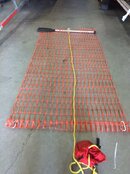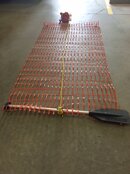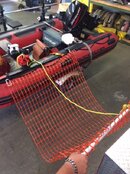I have been teaching surface water rescue and swiftwater rescue for over 10 years. We teach the "net" technique which we refer to as parbuckling. I took a piece of plastic snow fence about 8-10 feet long attached 2 carabiners to the corners on one end and a pole weaved through the other for weight and a line tied to the middle of the pole. The net is clipped on the boat and draped over the side. The victim is pushed up to the net and the line is tossed over the victim and into the boat, the rescuer then enters the boat pulls the line until they can grab the pole, the net should be wrapped around the victim. The rescuer can then pull up on the bar or carefully fall backwards rolling the victim up and into the boat. this creates mechanical advantage which lessens the load the rescuer has to pull. We also use 3 pieces of long webbing but this takes 2 rescuers in the boat. When I go to work this weekend I will take some photos and post them.
You are using an out of date browser. It may not display this or other websites correctly.
You should upgrade or use an alternative browser.
You should upgrade or use an alternative browser.
incapacitated diver recovery
- Thread starter Schwob
- Start date
Please register or login
Welcome to ScubaBoard, the world's largest scuba diving community. Registration is not required to read the forums, but we encourage you to join. Joining has its benefits and enables you to participate in the discussions.
Benefits of registering include
- Ability to post and comment on topics and discussions.
- A Free photo gallery to share your dive photos with the world.
- You can make this box go away
Stoo
Contributor
- Messages
- 3,505
- Reaction score
- 3,797
- # of dives
- 5000 - ∞
This parbuckling method is what I was referring to. I guess it gives a 2:1 advantage in lift which would certainly help...
I look forward to seeing the pics Resgdivemedic
I look forward to seeing the pics Resgdivemedic
Similar threads
- Replies
- 3
- Views
- 431
- Replies
- 59
- Views
- 6,503







